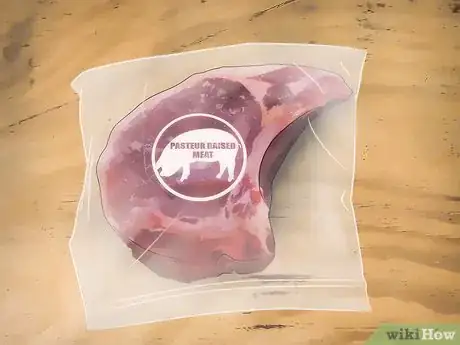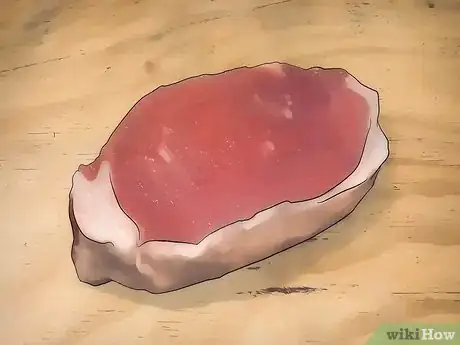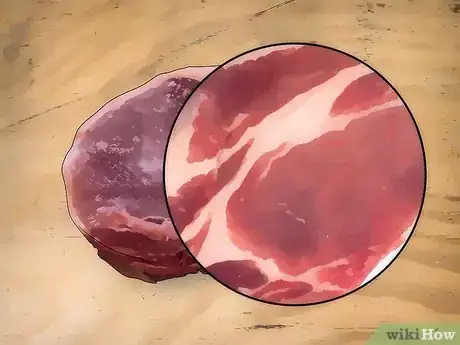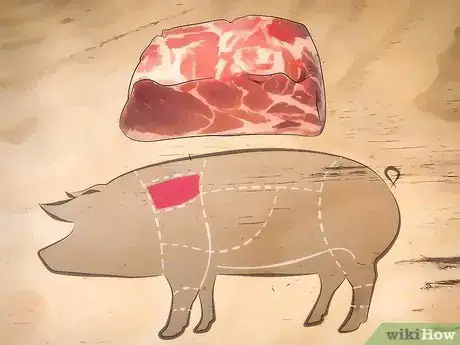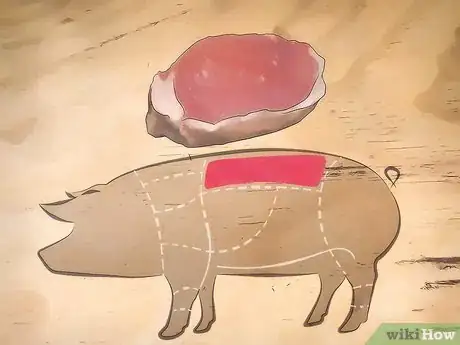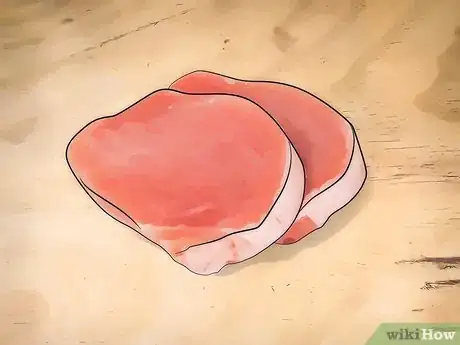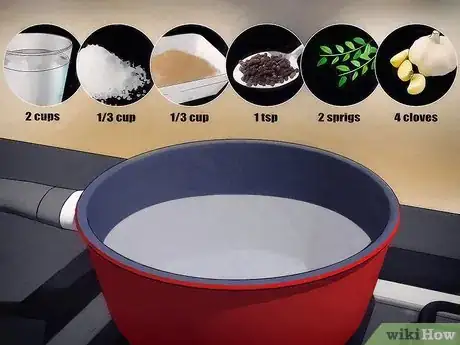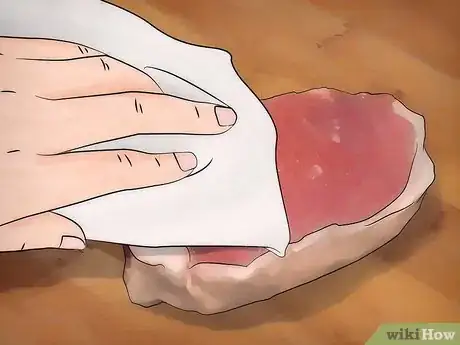This article was co-authored by wikiHow Staff. Our trained team of editors and researchers validate articles for accuracy and comprehensiveness. wikiHow's Content Management Team carefully monitors the work from our editorial staff to ensure that each article is backed by trusted research and meets our high quality standards.
This article has been viewed 47,588 times.
Learn more...
Pork chops are a versatile cut of meat that can be used in a wide array of dishes. Like other cuts of meat, pork chops vary in size, shape, flavor, and tenderness. By evaluating potential pork chops by appearance and cut, you can ensure consistent, high-quality meat in your dishes. Once your chops are chosen, you might even seal in their moisture with a simple brining.
Steps
Evaluating Pork Chops by Appearance
-
1Prioritize pasture raised pork. This feature should be clearly indicated on the label of potential pork chops, but in the event it is not, simply inquire with your butcher which pork chops are pasture raised. These cuts will be available at most butchers and groceries.
- In some cases, pasture raised pork can be a little more expensive than other varieties. If you're on a budget, you might want to avoid this kind of meat.
- Pasture raised pork generally has a better consistency, taste, and quality than "farm raised" pork, which usually refers to pigs raised and processed in an industrial style of butchery.[1]
-
2Opt for thicker cuts to prevent dryness. Much of the pork available today is raised to be as lean as possible, which can cause your meat to become easily overcooked. Thicker pork chops will retain moisture better, so you might want to ask for a double-cut for your chops, or specify you want yours at least 1½ inches (3.8 cm) thick.
- Bone-in cuts also help prevent the loss of moisture when cooking. If you find you have a problem with dryness in your chops, bone-in cuts may help with the problem.[2]
Advertisement -
3Ensure marbling by checking the meat. At most butchers, you'll have the option to look over the meat you plan on buying to inspect its quality. The most important feature for you to look for at this point is called "marbling," which is the presence of veins of white fat in the meat.
- Ideal pork chops will have a small amount of marbling throughout the chop and no yellow fat.
- Fat not only helps retain moisture in your meat, it also enriches the flavor of it. If you dislike fatty meat, you can always cut the fat out after it has been cooked.[3]
-
4Choose pink chops that are well packaged. The meat of your chops should be light pink in color. They should be wrapped in clean packaging that has no holes or tears. The packaging itself should have little to no leakage, and the tray in which the meat is presented should also have little to no fluid.[4]
- If you notice discoloration, like a graying or browning in your pork chops, your meat has already started to spoil.
- Smell is a great indicator of freshness. If you notice a sour, unpleasant, rotten, or decaying odor, your chops have spoiled and should be thrown away.
- Check the sell-by date on the packaging of your pork chops. If your meat has passed this date, it may be safest to throw the meat away.
Choosing Pork Chops by Cut
-
1Select a shoulder chop for rich flavor. Shoulder cuts have rich, dark meat that packs a lot of flavor. Because this cut is naturally high in fat, it's perfect for braising. However, you can also pan cook it regularly, so long as you tenderize it first.
- Due to the fact that this cut is rich in fat and other connective tissue, moist, high heat works best when cooking.
- You may be more familiar with the shoulder cut by one of its other names: the blade chop, blade-end pork loin chop, or pork steak.[5]
-
2Purchase rib chops for lean meat and mild flavor. The rib chop comes with a large eye of loin meat, but lacks tenderloin meat. There will be a bone running along one side of this cut that is often covered in a thin layer of fat. This cut will be relatively lean and have a mild flavor.[6]
- Since rib chops are a leaner cut, quick cook methods work well to seal in moisture in the meat. These include grilling, broiling, sear-roasting, and more.
- You'll find that rib chops are among the more tender cuts of pork chop you can buy. If tenderness is your preference, rib chops should be near the top of your list.
-
3Choose loin chops if you have time for careful cooking. Loin chops require a little more babysitting than other varieties. A t-bone will divide the loin meat from the tenderloin meat, and since these meats cook at different rates, you'll have to keep a close eye on them while cooking. The meat will be lean and have a mild flavor of pork.
-
4Opt for boneless chops for picky eaters. Some people dislike meat served with a bone. Additionally, younger children might struggle with cutting around bone-in cuts. In these cases, a boneless pork chop will work perfectly. Expect the meat to be lean, and the flavor to be mild.
- Boneless pork chop cuts are also known by as an America's cut or a pork loin fillet.
- These cuts will have very little marbling, fat, and connective tissue, which means there will be a greater risk of overcooking. For this cut, you should consider brining your pork chop.
-
5Save sirloin chops for slow cooking situations. This cut will have pieces of hip and backbone in it. The meat of this cut is comprised of many different muscle groups. It has a very strong pork flavor and, as the meat can be tough, it should be slow cooked to encourage tenderness.
- Slow, moist heat will best break down the tissues in a sirloin chop, softening the tough meat into a delicious meal. Keep this cut in mind for braises and stews.[8]
Brining Your Pork Chops
-
1Identify lean pork chops for brining. Brining your pork chops will help your meat retain moisture after being cooked. This is especially important for lean chops that don't have much fat marbling the meat, as these will dry out more easily during cooking.
- Marbling is a butcher's term that refers to the visible presence of fat, which often appears as white veins in the meat.
- Even meat with good marbling can be made juicier by brining. If you like your meat to be juicy, you might want to consider brining your chops from now on.[9]
-
2Make a brine for your pork chops. In a small or medium sized saucepan, mix together 2 cups of water, 1/3 cup of kosher salt, and 1/3 cup brown/granulated sugar over medium heat. Add to the mixture 1 teaspoon of black peppercorns, 2 sprigs of thyme, and 4 cloves of garlic. Stir the mixture with a spoon until the salt and sugar have dissolved.
- You'll have to let your brine cool first before using it. You can speed up with process by adding some ice cubes to your cooling brine.
- This recipe makes enough brine for 2 pork chops. You can adjust the ingredients proportions if you're making fewer or more than 2 pork chops.[10]
-
3Put your brine in a sealable plastic baggie. You'll want your plastic baggie to be large enough to accommodate your pork chop, but not so large that the brine settles to the bottom of the baggie and does not completely submerge the chop. You may find it easiest to split your brine equally between 2 medium sized baggies, one for each chop.
- You should prioritize plastic baggies with a heavy duty seal. Some cheaper baggies may spring a leak and get brine all over your refrigerator.[11]
-
4Insert the chop into your baggie and refrigerate it. Put your chop into the baggie with your brine and seal it closed. For best results, you'll want your chop to sit in the brine at least 8 hours, so you may want to leave it in your refrigerator overnight.
- Even if you don't have a full 8 hours to brine your chops, as few as 2 hours of brining can improve the juiciness of your meat.
- Generally, you should not brine meat for more than 12 hours. Doing so will have no noticeable impact on the meat.[12]
-
5Remove your chops and pat-dry the excess brine. You may want to remove the meat from its baggie with a tool, like a pair of tongs, but you should be able to guide your chop out by holding the corners opposite the mouth of the baggie and letting gravity pull the chop free. Excess brine that remains on the chop can be patted dry with clean paper towel.
- Generally, before cooking your pork chops but after you remove excess brine, you should allow your chops to return to room temperature. This will help preserve the quality of the meat.[13]
-
6Cook your pork chops and enjoy. Now that your pork chops are well brined and at room temperature, they're ready to be cooked in whatever fashion you desire. Some options you might consider for cooking your prepared pork chop include pan frying a breaded cutlet, grilling it, or braising it.
Community Q&A
-
QuestionWhat's the best pork chop for crock pot cooking?
 Community AnswerThe thicker the cut, the longer you can slow cook them. Slow cooking pork makes for pull-apart meat. The idea itself is for tenderizing tough meats, so you want something that will hold up a little longer. Otherwise, you'll have pulled "pork chop" sandwiches.
Community AnswerThe thicker the cut, the longer you can slow cook them. Slow cooking pork makes for pull-apart meat. The idea itself is for tenderizing tough meats, so you want something that will hold up a little longer. Otherwise, you'll have pulled "pork chop" sandwiches.
References
- ↑ https://food52.com/blog/11213-all-about-pork-chops
- ↑ https://www.thekitchn.com/a-complete-guide-to-pork-chops-meat-basics-208638
- ↑ http://www.porkbeinspired.com/cuts/chops/
- ↑ http://www.porkbeinspired.com/cuts/chops/
- ↑ https://www.thekitchn.com/a-complete-guide-to-pork-chops-meat-basics-208638
- ↑ http://www.porkbeinspired.com/cuts/chops/
- ↑ https://www.thekitchn.com/a-complete-guide-to-pork-chops-meat-basics-208638
- ↑ https://www.thekitchn.com/a-complete-guide-to-pork-chops-meat-basics-208638
- ↑ https://www.thekitchn.com/a-complete-guide-to-pork-chops-meat-basics-208638
